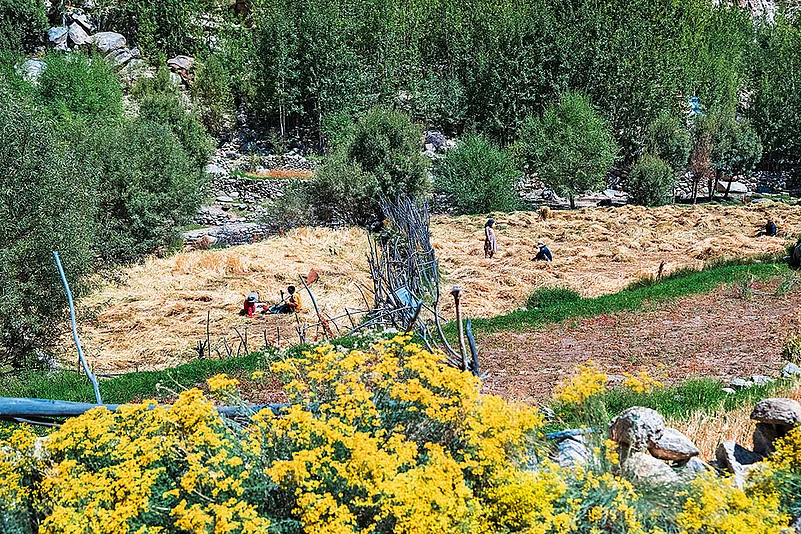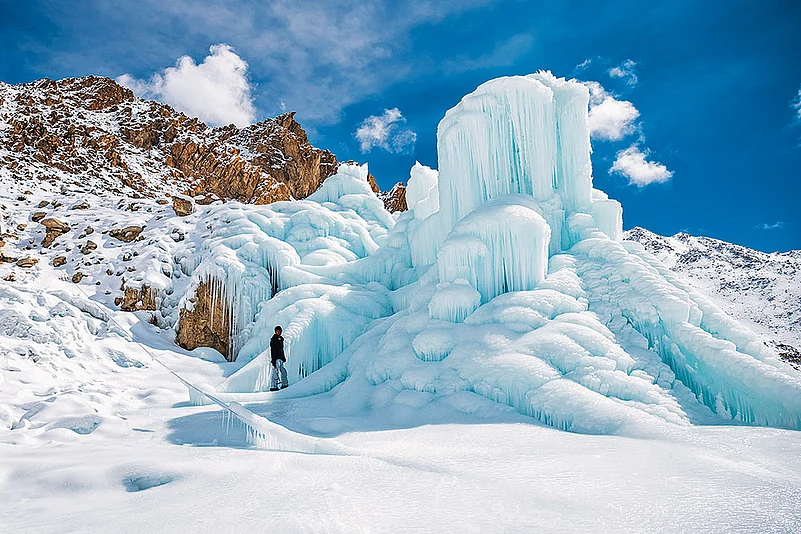In the arid, cold desert region of Ladakh, artificial cone-shaped structures dot the landscape. Termed ice stupas for their mound-like shape, meltwater from the structures provides essential irrigation water during the sowing season in spring and early summer.
Ice stupas, some of which tower over 30m, have been gaining popularity across Ladakh since the early 2010s as communities scramble together to find ways to combat glacial recession and unpredictable snowfall.
The local solution triggered an idea and in 2023, Acres of Ice, a water-management company, was born—founded by Basit Afzal and Suryanarayanan Balasubramanian who met through work and joined forces to scale up the innovation and automate its deployment.
Still Waters
The Srinagar of Afzal’s childhood was a city blessed with a plenitude of water. Water was an integral part of life, he recalls, with houseboats bobbing on Dal Lake and the Jhelum meandering through the city.
Trained in soil and water conservation, he only came to understand scarcity of water in high-altitude regions when he went to Ladakh in 2011 to implement projects for a Srinagar-based irrigation company.
While working on irrigation projects, Afzal met Balasubramanian in 2016, a scientist bringing together communities for water management. Balasubramanian had also worked with education reformist Sonam Wangchuk, the brain behind the design of manual ice stupas.
In 2019, Afzal moved to the United Kingdom as a water management specialist. At the time, Balasubramanian was in Switzerland, working on a PhD in geosciences, but the two remained in touch.
Then, in 2022, over a phone conversation, the idea of a start-up was born. But it would take another year before Acres of Ice began operations, with its headquarters in Ladakh. Started as a two-person team, the company now has 14 employees—a mix of local experts and specialists from different states.
New Ice Age
The idea behind an ice stupa—a type of ice reservoir—is to store winter runoff water. Water from upstream that would otherwise go unused or freeze is guided through pipes under the force of gravity to lower altitude areas, near a natural stream. A nozzle or sprinkler is installed at the site and sprays the water into the cold air.
In sub-zero temperatures, the water freezes mid-air in layers, forming a conical structure. The shape of the stupa exposes less surface area to sunlight and slows down the melting process. Sensors and valves are added to control the flow and make ice formation efficient.

This automated ice reservoir (AIR) can store up to 4mn litres of water. When temperatures rise, the outer layers of ice start to melt from the top down and drain into the stream next to it, providing much-needed water for irrigation and drinking.
All of this comes at a cost. According to Afzal, the cost of automating an ice stupa can be anywhere in the Rs 15–25 lakh range. Tailored policy support, essential for their innovation, does not exist yet, he adds.
In the beginning, Acres of Ice was bootstrapped for one-and-a-half years. During this time, the two co-founders invested Rs 30 lakh and worked with organisations such as GlaciersAlive, King’s College London, the National Bank for Agriculture and Rural Development (Nabard), Cover Project Foundation, the Ladakh Autonomous Hill Development Council, University of Fribourg, Switzerland and Mercy Corps Ventures that supported the start-up through funding or grants.
Automating an ice stupa can cost anywhere in the Rs 15–25 lakh range. Tailored policy support for the innovation does not exist yet
The Food and Agriculture Organisation also extended monetary support through its Mountain Partnership programme. In 2024, Acres of Ice executed projects worth Rs 1.2 crore, says Afzal, adding that for financial year 2026, the company was aiming for a revenue of Rs 2 crore.
“In a few years, we will roll out new products like glacial lake-outburst flood-mitigation analysis services, tailored for different geographies,” Afzal says. “It’s an exciting time because some nations are showing interest in installing this project in high-altitude regions that face challenges similar to Ladakh,” he adds.
Ebbs and Flows
But in the meantime, the start-up faces considerable operational challenges. “Building a team that can work in altitudes above 4,000m and in sub-zero weather is one of the biggest challenges,” Afzal says.
“Working with local community is also tricky when there is a communication gap. You have to explain the benefits and the process of this particular technology,” he adds.
Hurdles aside, both co-founders believe that Acres of Ice is helping mountain communities flourish, despite environmental challenges. “We integrate traditional knowledge with cutting-edge technology to create sustainable, automated systems that conserve water resources and build climate resilience across mountain regions worldwide,” says Balasubramanian.
Over a quarter of the world’s population relies on water resources originating from the Himalayas, which makes glacier conservation in the region essential for safeguarding water security.
“Ensuring water security—particularly for irrigation—is a crucial focus in Ladakh. The project aimed at automating ice reservoirs represents a significant step toward this goal and we are very excited about the innovative technology introduced by Acres of Ice,” says Tsewang Dorjey, district development manager, Nabard.
Until then, the start-up's climate-adaptive technology is helping undo some of the damage caused by global warming. “By bridging the gap between water conservation and efficient utilisation, we aim to transform vulnerable regions into models of sustainability and self-sufficiency,” says Balasubramanian.











